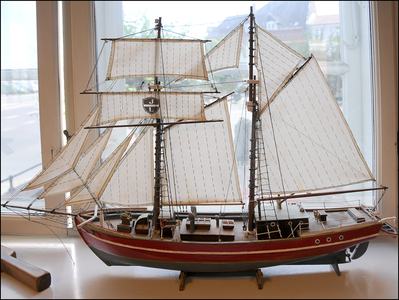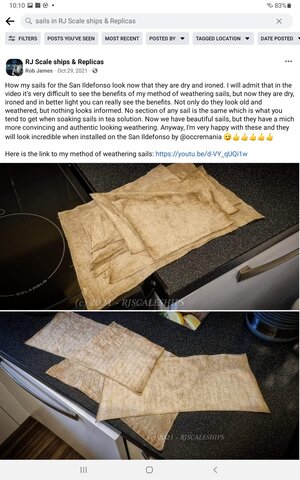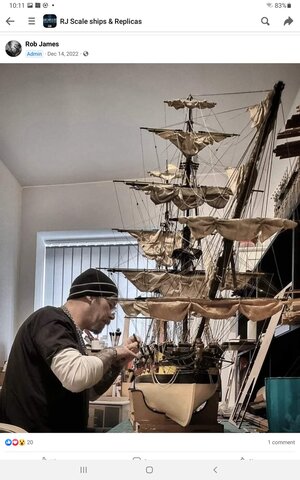What about the smell?I stained my sails with pine tar and kerosene. Who knows how long that will last.
-

Win a Free Custom Engraved Brass Coin!!!
As a way to introduce our brass coins to the community, we will raffle off a free coin during the month of August. Follow link ABOVE for instructions for entering.
You are using an out of date browser. It may not display this or other websites correctly.
You should upgrade or use an alternative browser.
You should upgrade or use an alternative browser.
Sails or No Sails
- Thread starter KeithLyall
- Start date
- Watchers 24
Typo - 'sewing hands'?Can you translate this from Australian to English ?
- Joined
- Nov 28, 2020
- Messages
- 160
- Points
- 88

La solución intermedia es poner algunas velas que no tapen mucho, como los foques y las escandalosas. Otra es poner las velas recogidas en sus vergas. SaludEstoy en la etapa de los mástiles, vergas, aparejos y velas en mi Occre Endeavour. Tengo un conjunto de velas y estoy tratando de decidir si colocar las velas o no. Una parte de mí es de la opinión de que es un barco de vela, por lo que las velas son esenciales, otra parte es que las velas ocultarán gran parte del aparejo del modelo. Mi media naranja está en el campamento NO Sails para evitar atrapar polvo. ¿Alguna idea? Además, si tuviera que poner velas, ¿cuándo sería mejor hacerlo? Actualmente, las vergas no están unidas a los mástiles, por lo que es mejor unir las velas a las vergas y lueglo instalar las vergas O unir las vergas a los mástiles y luego unir las velas. No he hecho esto antes, pero poner velas en las vergas y luego unir las vergas a los mástiles es posiblemente más fácil, pero agradezco cualquier opinión de aquellos con experiencia. Gracias.
- Joined
- Nov 28, 2020
- Messages
- 160
- Points
- 88

Si tanto te molesta, velas nuevas....¿Qué pasa con el olor?
After giving this some pondering, I have come to a different view about the coloring or weathering of sails. In my opinion, the sails should match the ship model itself. Most of us build our master pieces as new, clean, sharp, fresh out of the shipyard models. And praised for our sharp, clean modeling skills. Rarely does one go to the effort of actually aging or weathering our models. Therefore we should match our sails to our new, clean, sharp, fresh out of the shipyard ship models. That would call for natural colored cloth simulating new canvas. Does not mean stark white. For most of us we need the look of new canvas. We should not be looking to mount aged weathered sails on our new models. Just a thought…match the state of the sails to the state of the ship itself…
Hi
The Endeavour comes with 17 sails. I installed all of them which is very crowded.
Would it have been usual to set all the sails at the same time. Or are the square sails used at a different time as the jib/triangular sails
I think it may have made my build look better with fewer sails and allowed the masts and rigging to be more visible
Does anyone know how the sails were set under different sailing conditions?
The Endeavour comes with 17 sails. I installed all of them which is very crowded.
Would it have been usual to set all the sails at the same time. Or are the square sails used at a different time as the jib/triangular sails
I think it may have made my build look better with fewer sails and allowed the masts and rigging to be more visible
Does anyone know how the sails were set under different sailing conditions?
- Joined
- Oct 9, 2020
- Messages
- 2,190
- Points
- 488

interesting video. In my head I was just dipping the sail in tea. His method gives a more realistic look with the tea granules. I will keep this in mind.Modelling sails can be problematic. I found the Rob James treatment of sails to be excellent and willse his methods when I get there on my current build. He has a facebook page and a YouTube posting on sail prep. Worth the read.
View attachment 353040View attachment 353041
- Joined
- Nov 28, 2020
- Messages
- 160
- Points
- 88

nunca pongo velas super blancas. Las velas eran de lona y por tantol color del hilo crudo. De todas formas muchos compañeros las tintan con infusión de té. Cuado empecé a hacer modelísmo hice 3 kits y luego pasé a trabajar sobre planos. Tiene mucho más trabajo pero más satisfacciones, cuando consigues hacer detalles complicados y nunca me quedan como recién salido de astillero, siempre como que ha navegado un tiempo .Después de reflexionar un poco sobre esto, he llegado a un punto de vista diferente sobre el color o el desgaste de las velas. En mi opinión, las velas deberían coincidir con el modelo de barco en sí. La mayoría de nosotros construimos nuestras obras maestras como modelos nuevos, limpios, nítidos, recién salidos de los astilleros. Y elogiado por nuestras habilidades de modelado nítidas y limpias. Rara vez uno hace el esfuerzo de envejecer o desgastar nuestros modelos. Por lo tanto, debemos hacer coincidir nuestras velas con nuestros modelos de barcos nuevos, limpios, afilados y recién salidos del astillero. Eso requeriría una tela de color natural que simule un lienzo nuevo. No significa blanco puro. Para la mayoría de nosotros, necesitamos el aspecto de un lienzo nuevo. No deberíamos buscar montar velas envejecidas y desgastadas en nuestros nuevos modelos. Solo un pensamiento... haga coincidir el estado de las velas con el estado del barco en sí...
- Joined
- Feb 15, 2019
- Messages
- 371
- Points
- 168

A full set would be used when sailing 'large' that is with the wind from astern, the spanker might not be set. For anything else sails are set and trimmed according to conditions and whether manouvering into, say an attack position, maybe tops'ls only. The choice is yours depending on how you want to present your ship. A brig would run with a fore course, there is no point setting the main course because it would steal the wind from the fore course.Hi
The Endeavour comes with 17 sails. I installed all of them which is very crowded.
Would it have been usual to set all the sails at the same time. Or are the square sails used at a different time as the jib/triangular sails
I think it may have made my build look better with fewer sails and allowed the masts and rigging to be more visible
Does anyone know how the sails were set under different sailing conditions?
- Joined
- Feb 15, 2019
- Messages
- 371
- Points
- 168

Bear in mind the sails are never the same age as the ship. You can easily lose all sails in a storm, they would blow out sometimes leaving only the bolt ropes. There might be a mix of old and new! When adding distressed linen the old adage of less is more holds true. Hence my aversion to a full set of tea stained sails, you can safely bet this would never be the case. Storms and losses were unavoidable which is why the holds were full of sailcloth and timber for replacements as well as a carpenter and sail maker on every ship.After giving this some pondering, I have come to a different view about the coloring or weathering of sails. In my opinion, the sails should match the ship model itself. Most of us build our master pieces as new, clean, sharp, fresh out of the shipyard models. And praised for our sharp, clean modeling skills. Rarely does one go to the effort of actually aging or weathering our models. Therefore we should match our sails to our new, clean, sharp, fresh out of the shipyard ship models. That would call for natural colored cloth simulating new canvas. Does not mean stark white. For most of us we need the look of new canvas. We should not be looking to mount aged weathered sails on our new models. Just a thought…match the state of the sails to the state of the ship itself…
- Joined
- Oct 9, 2020
- Messages
- 2,190
- Points
- 488

when trying to achieve maximum speed, does that mean all sails are down?Bear in mind the sails are never the same age as the ship. You can easily lose all sails in a storm, they would blow out sometimes leaving only the bolt ropes. There might be a mix of old and new! When adding distressed linen the old adage of less is more holds true. Hence my aversion to a full set of tea stained sails, you can safely bet this would never be the case. Storms and losses were unavoidable which is why the holds were full of sailcloth and timber for replacements as well as a carpenter and sail maker on every ship.
It dissipates after you use rags to soak away the kerosene. The rest evaporates in about two days. Pine tar smells of fireplace smoke, and that scent lingers a small amount. Smells like a real ship!What about the smell?
Would washing a sail in baking soda neutralize the acid in the tea leaf stains?
- Joined
- Sep 3, 2021
- Messages
- 5,137
- Points
- 738

I wholeheartedly agree with the above.This is the fore topsail from HMS Victory, taken off the ship after the battle of Trafalgar October 1, 1805. This sails shows what dirt and 200 years of age will do to canvas. Sails do get dirty with age and use. This is why old timer modelers used tea to stain sails. It was the stain they had at hand, and they were unaware of it's long term effects due to acidity. The color of sails is largely personal preference, from ivory (cream white) to dark from dirt and age. You have to choose what you prefer for your model. If you want the new look, use an off-white or ivory color. Canvas was not bleached white like it appears today but was it's natural color. I like to have a little brownish or tan in my sails to suggest some usage. If your model is neat and pristine painted like brand new, you may want almost white sails.
View attachment 352913
agreeAfter giving this some pondering, I have come to a different view about the coloring or weathering of sails. In my opinion, the sails should match the ship model itself. Most of us build our master pieces as new, clean, sharp, fresh out of the shipyard models. And praised for our sharp, clean modeling skills. Rarely does one go to the effort of actually aging or weathering our models. Therefore we should match our sails to our new, clean, sharp, fresh out of the shipyard ship models. That would call for natural colored cloth simulating new canvas. Does not mean stark white. For most of us we need the look of new canvas. We should not be looking to mount aged weathered sails on our new models. Just a thought…match the state of the sails to the state of the ship itself…
- Joined
- Jun 13, 2022
- Messages
- 303
- Points
- 168

Wow that is some build … looks superbModelling sails can be problematic. I found the Rob James treatment of sails to be excellent and will use his methods when I get there on my current build. He has a facebook page and a YouTube posting on sail prep. Worth the read.
View attachment 353040View attachment 353041
- Joined
- Feb 15, 2019
- Messages
- 371
- Points
- 168

When the conditions allow and the wind is astern, then stuns'ls set for maximum speed. Read the Patrick O'Brian books to get an impression of life aboard, there are 20 of them, enjoy!when trying to achieve maximum speed, does that mean all sails are down?
Kurt Konrath
Kurt Konrath
Having sailed small craft, I know use of sails depends on the wind.
Under light to moderate winds more sails are used to get the most of wind available.
I gusty and high winds, fewer sails are used to prevent gusts from driving the ship to hard or ripping the sails from the yard arms, or masts.
Many ships would keep near full sails deployed but reef the sails to reduce the area the wind has to catch.
On tall ships one has to figure out if the upper sails only are used if they could cause the ship to heal over in a heavy gust of wind.
Under light to moderate winds more sails are used to get the most of wind available.
I gusty and high winds, fewer sails are used to prevent gusts from driving the ship to hard or ripping the sails from the yard arms, or masts.
Many ships would keep near full sails deployed but reef the sails to reduce the area the wind has to catch.
On tall ships one has to figure out if the upper sails only are used if they could cause the ship to heal over in a heavy gust of wind.
Yes, I know, but it was not often the sea was flat. I have myself been sailing two Weeks on the Danish Top-Sail WSchooner Lilla Dan. my model wis from 1982. Still sailing out of CopenhagenWhen the conditions allow and the wind is astern, then stuns'ls set for maximum speed. Read the Patrick O'Brian books to get an impression of life aboard, there are 20 of them, enjoy!






